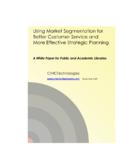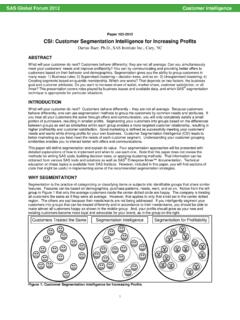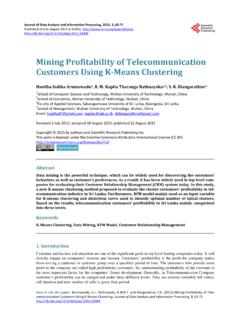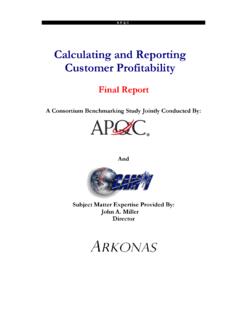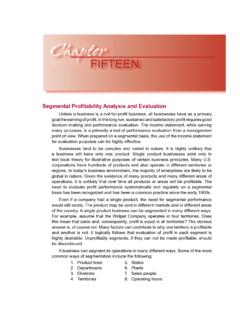Transcription of State Farm and GEICO Case Studies: Using Segmentation to ...
1 State Farm and GEICO case studies : Using Segmentation to Uncover Profitable customer Retention Opportunities A Management Discussion Based on the 2009 Personal Insurance Retention AnalysisSM. Financial Services and Insurance Research Group April 2009. A Global Marketing Information Company | 37309843650/042109. State Farm and GEICO case studies : Using Segmentation to Uncover Profitable customer Retention Opportunities Retaining Auto and Homeowners Insurance Customers in a Slowing Economy Sales of new light vehicles in the United States have historically been sensitive to the ups and downs of overall economic conditions. Meanwhile, the personal auto insurance market has been remarkably stable during the past 5 years (Figure 1), according to financial data from Standard and Poor' In this mature market, individual insurance companies tend toward a zero-sum game, where the growth of one company comes at the expense of another.
2 To grow, an insurer must both protect its current book of business and conquest new customers. Given the significant cost involved in acquiring new policyholders, personal auto insurers have traditionally focused their efforts on maximizing policyholder retention especially among those customers they view to be the most valuable, whether in the short or long term. The current economic recession, which most experts agree began in December 2007, has heightened the importance of customer retention. Insurers are working to shore up their retention rates as well as financials in the face of lackluster investment performance. 5-Year Personal Auto Industry Premium Trend . 170. The current economic 165 165 recession, which most experts 165 agree began in December 2007, 163.
3 162 has heightened the importance of $ in Billions 161. customer retention. 160. 155. 150. 2003 2004 2005 2006 2007. Year Figure 1. Source: Standard and Poor's, based on statutory findings For the past 5 years, Power and Associates has published average customer retention rates for each of the top insurers in the personal auto and homeowners insurance markets. The Power and Associates 2009 Personal Insurance Retention AnalysisSM. is based on surveys gathered from more than 275,000 auto insurance customers. The survey was fielded from January to March 2009 and benchmarks 32 of the nation's largest personal auto insurers. (See Appendix for a complete list of profiled insurers.). The complete retention analysis, which provides segmented retention performance and defection patterns for each of these profiled insurers, will be available by subscription to the Power and Associates 2009 Insurance Shopping Study,SM which will publish in June 2009.
4 2009 Power and Associates, The McGraw-Hill Companies, Inc. All Rights Reserved. 2. State Farm and GEICO case studies : Using Segmentation to Uncover Profitable customer Retention Opportunities This Management Discussion includes an examination of some of the pronounced variations in customer retention performance between customer segments of two national insurers, GEICO and State Farm, which will demonstrate the kinds of opportunities the full analysis will identify for each of the profiled insurers. In addition, a financial model and the underlying assumptions are used in a number of instances to estimate the incremental premium that select insurers may realize if they successfully apply targeted strategies to improve retention for segments of their book.
5 Industry Retention Trends For the industry overall, auto policyholder retention has remained fairly stable at close to 89% during the past 5 years, according to Power and Associates' research. However, individual insurer performance is more volatile. For example, Progressive has made significant strides in improving customer satisfaction and retention during the past 5 years while AIG has suffered significant setbacks during the past year, presumably as a result of their highly publicized financial challenges and related government assistance. (Figure 2). Personal Auto Retention Rate Trend . 100%. Industry Annual Retention Rate 90% State Farm GEICO . 80% Progressive AIG. 70%. Allstate 60%. 50%. 2007 2008 2008 2009. Year Figure 2.
6 Source: Power and Associates 2008 Insurance New Buyer and 2009 Insurance Shopping StudiesSM. In segmenting auto insurance customers based on purchase behavior, there has been a remarkably stable 12% difference in the retention rates of households that bundle auto and homeowners insurance from the same insurer, compared with monoline auto insurance customers (95% vs. 83%, respectively, this year). This phenomenon was explored in detail in the Power and Associates 2008 Insurance Shopping StudySM Management Discussion, Winning and Losing Customers in Personal Auto Insurance. 2. Examining policy retention by generational cohort reveals that Baby Boomers (born between 1946 and 1963) renew at a significantly higher rate (92%), compared with Generation X.
7 (born from 1964 to 1984) or Generation Y (born from 1985 to 1991) customers, who renew at rates of 88% and 80%, respectively. Pre-Boomers (born before 1946) renew at the highest rate, 93%. 2009 Power and Associates, The McGraw-Hill Companies, Inc. All Rights Reserved. 3. State Farm and GEICO case studies : Using Segmentation to Uncover Profitable customer Retention Opportunities The Relationship between customer Satisfaction and Retention Since 2005, Power and Associates has tracked the relationship between customer satisfaction, customer retention, and profitability for each of the nation's largest insurers. (Figure 3) These analyses reveal a significant financial benefit to each insurer of increasing customer satisfaction, one customer at a time.
8 Simultaneously, Power and Associates'. research in the personal auto insurance marketplace highlights numerous performance improvement opportunities and their impact on customer satisfaction. The value that a personal automotive insurance customer represents to their insurer is usually realized over the long term. For many insurers, individual customers do not become profitable until their third or fourth year of tenure after the insurer recoups the costs associated with acquiring that new customer . Therefore, the extent to which insurers are better able to retain current customers has a direct impact on their bottom-line profitability . Auto Insurance Study Index vs. Retention . 100%. Annual Retention Rate 90%. For many insurers, individual customers do not become profitable 80% until their third or fourth year of tenure after the insurer recoups the costs associated with acquiring 70% that new customer .
9 60%. 740 760 780 800 820 840 860 880 900. Auto Insurance Study Index Figure 3. Source: Power and Associates 2008 National Auto Insurance and 2009 Insurance Shopping StudiesSM. Each data point represents the average 2008 satisfaction index score and 2008-2009. retention rate for one of the 26 separate insurance companies profiled in the 2009 Insurance Shopping StudySM. 2009 Power and Associates, The McGraw-Hill Companies, Inc. All Rights Reserved. 4. State Farm and GEICO case studies : Using Segmentation to Uncover Profitable customer Retention Opportunities case studies : State Farm vs. GEICO . Like the industry as a whole, both GEICO and State Farm are better able to retain older customers than younger customers. (Figure 4) Comparing the two insurers, State Farm has higher retention rates across all generational groups and is able to retain Generation Y.
10 Customers (88%) almost as well as GEICO retains Baby Boomers (90%). However, GEICO 's retention rate among Generation Y customers underperforms the industry at only 78%. To estimate the financial impact of increased customer retention, Power and Associates has developed a model based on conservative estimates of policy growth, profitability , and premium Using this model, if GEICO could halve the Generation Y retention gap with State Farm, the improvement could yield more than half a billion dollars of additional premium over a 5-year customer Generation and Retention . Retention Rates 0 79% 80 84% 85 89% 90 94% 95 100%. Industry Average State Farm Pre-Boomers Gen Y Pre-Boomers Gen Y. Boomers Gen X Boomers Gen X. GEICO Progressive Pre-Boomers Gen Y Pre-Boomers Gen Y.
